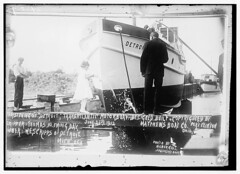(For the few who might not have been born yet when the events at Jonestown took place thirty years ago or who are otherwise uninformed, an American religious leader, Jim Jones, led over nine hundred of his followers to the jungles of Guyana, South America, to set up an experimental agricultural colony. He went completely mad, and induced almost all of his followers to take their own lives, and the lives of their children, mostly by drinking Flavor-Aid laced with poisonous cyanide.)
Someone commented, “What planet were they ON?” Answer: a very small and compact planet, the Jonestown settlement. And the mind-control aspects of cults are well known, as is the fact that for every charismatic, manipulative leader there seem to be dozens, if not hundreds, of unquestioning, sheeplike followers.
Some years ago in Haiti I witnessed a similar scenario, although in this case the preacher himself was the victim. Earlier in the day it had rained. The boss was checking on some equipment in one of the sheds on the site, and slipped on the rain-soaked wooden stairs. He somersaulted down the steps and came down hard on his back, breaking a scapula. I drove him to the Hopital General in downtown Port-au-Prince in the hope of getting an x-ray of the shoulder and some sort of medical treatment.
Although the hospital itself seemed like something out of the pages of Dante’s Inferno, they did have some x-ray equipment, and the staff did their best to accommodate us. The process took the better part of two hours. During this time a young, earnest blond-haired American showed up at the hospital. He seemed extremely upset. He said he was a missionary from a Pentecostal denomination, one that I wasn’t really familiar with.
“So, you’ve been out there in the village this whole time?” I asked. He said that he had. “And what kind of food do you eat?” I asked.
“I eat what the people eat,” he said. “I didn’t come here to lord it over them and have my own special food. What’s good enough for them is good enough for me.” It was then I noticed that he had sores on either side of his mouth. I remembered from somewhere in my past (an eighth-grade science class, perhaps?) that this was a symptom of some kind of deficiency disease, like pellagra or beri-beri. (It’s actually caused by a lack of vitamin B-12 in the diet.)
“Dude, I’m not a doctor,” I began, “but I think it’s really a good idea to take vitamin pills while you’re here. I mean, I do, and I feel much better.”
I was about to tell him about the sores at the sides of his mouth, and how it was caused by his diet, when one of our Haitian engineers rushed into the hospital. He’d heard about the accident via the jungle telegraph, and had come looking for us. He’d already made arrangements for the boss to be examined at a private hospital in Petionville, where one of his cousins was a doctor.
I went to wish the missionary good luck. He was still looking out at the trees into the darkened street outside. “Look! Was that a bat?” he said. I never ran into the guy again. I hope he remembered to buy a bottle of vitamins before he went back to the village.






